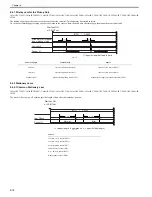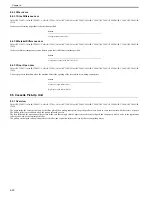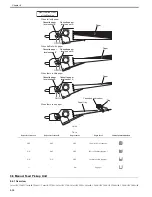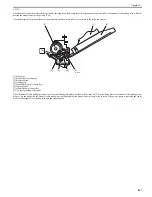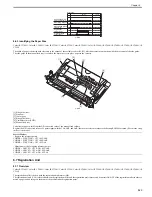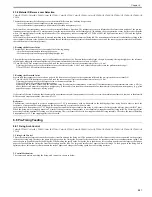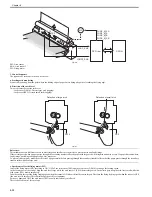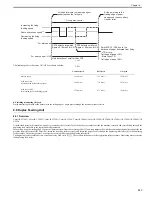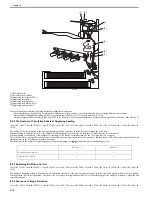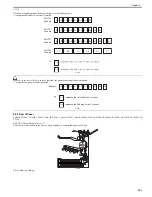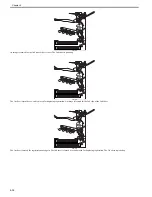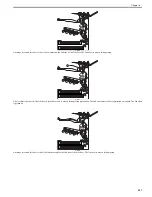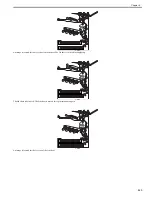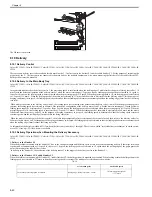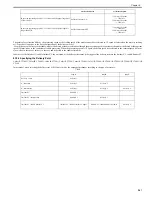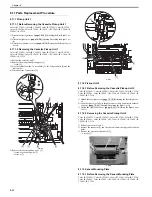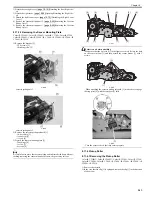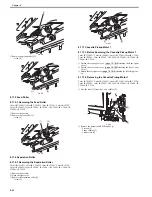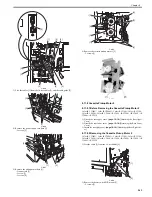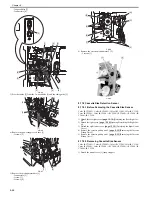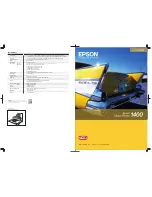
Chapter 8
8-31
8.7.4 Material Difference Jam Detection
0014-3046
Color iR C3380G / Color iR C2880G / Color iR C3380i / Color iR C3380 / Color iR C2880i / Color iR C2880 / iR C3480 / iR C3480i / iR C3080 / iR C3080i / iR
C2550
The machine determines the following cases as the material difference jam, and stop its operation.
- In case the material is non-transparency when transparency is set.
- In case the material is transparency when material other than transparency is set.
In this machine, one transparency sensor is used for material difference detection. The transparency sensor is allocated at the almost same position of the pre-reg-
istration sensor (a point where 21.5 mm upstream from the registration roller) on the feeding path. (In addition, the pre-registration sensor is allocated at the point
where 19.9 mm upstream from the registration roller.) The transparency sensor is comprised of 2 PCBs of LED; the light emission area (UN18) and the light re-
ception area (UN19).
In this machine, the material difference is detected according to the transmittance of material being fed. The transmittance of material is calculated according to the
sensor output (reference value A) under the condition that no shielding material presents at the transparency sensor, and the sensor output (measured value B) under
the condition that a fed material presents.
1. Reading the Reference Value
The reading of the reference value is executed at the following timing:
- After warm-up rotation when turning the power on.
- After warm-up rotation after opening/closing the right door.
The prism facing to the transparency sensor is allocated at the right door side. Because the detected voltage changes by opening/closing the right door, the reference
value must be measured after opening/closing it. Measurement method of the reference value is as follow:
1) Turn ON the LED of transparency sensor, and read the sensor output 3 times with constant interval (every 16 ms).
2) Among the read values, save the smallest value as the reference value A (the 3 read values fall somewhere into the predetermined range).
3) Turn OFF the LED and finish the measurement.
2. Reading the Measured Value
Start to read the transparency sensor when a paper is fed from a source of paper to the registration roller and the pre-registration sensor turns ON.
1) Turn ON the LED of transparency sensor, and read the sensor output 3 times with constant interval (every 16 ms).
2) Among the read values, save the largest value as the measured value B.
3) Turn OFF the LED and finish the measurement.
4) Based on the reference value A and the measured value B, calculate the transmittance of material. If the transmittance is the predetermined value (=45%) or
above, the detected material is judged as a transparency. If the result is less than the predetermined value, the material is judged as non-transparency (e.g., plain
paper, heavy paper, color paper, tracing paper).
If the result of the step 4 indicates that the material is non-transparency while transparency is set and vice versa, the machine considers as a jam due to the material
difference, and stops the machine. (Jam code: 0D93)
Reference:
The detection is not designed to protect a transparency for CLC (a transparency with a white mark on the leading edge) from being fixed in order to avoid the
occurrence of symptoms that cause damage on the fixing assembly or error codes when it is used.
In this machine, a transparency for CLC might be wrapped around the fixing assembly when using it, and it causes the fixing inside delivery delay jam (0107 jam).
When the fixing motor is stopped because of a jam detection processing, a transparency is not completely wrapped around the fixing roller. By executing the jam
processing from the upstream of feeding as a jam processing flow, it prevents the sheet to be wrapped around the fixing assembly. Therefore, the control detecting
a transparency for CLC and stopping print is not executed.
8.8 Pre-Fixing Feeding
8.8.1 Fixing Arch Control
0014-3187
Color iR C3380G / Color iR C2880G / Color iR C3380i / Color iR C3380 / Color iR C2880i / Color iR C2880 / iR C3480 / iR C3480i / iR C3080 / iR C3080i / iR
C2550
1. Fixing Arch Control
This is the control performed between the secondary transfer unit and the fixing unit. The perimeter of the roller increases due to heat expansion on the pressure
roller of the fixing unit. Therefore, the paper feeding speed on the fixing side becomes faster than the one for secondary transfer at constant rotation speed. This
causes papers to be pulled towards the fixing side. When making the speed on the fixing side lower than the one for secondary transfer to make larger arch of paper,
papers are pushed into the fixing side from the secondary transfer side. Too large and small arch of papers affects the image. To feed papers to the fixing unit at
optimum status, this control system monitors the arch of papers and changes the feeding speed due to according its status.
2. Control Mechanism
The sensors and motors regarding the fixing arch control are shown as below.
Summary of Contents for CiRC2550
Page 2: ......
Page 27: ...Chapter 1 Introduction ...
Page 28: ......
Page 47: ...Chapter 1 1 18 F 1 14 ON OFF ON OFF ...
Page 70: ...Chapter 1 1 41 5 Turn on the main power switch ...
Page 79: ...Chapter 2 Installation ...
Page 80: ......
Page 85: ...Chapter 2 2 3 Not available in some regions ...
Page 134: ...Chapter 3 Basic Operation ...
Page 135: ......
Page 137: ......
Page 143: ...Chapter 4 Main Controller ...
Page 144: ......
Page 152: ...Chapter 4 4 6 F 4 6 CPU HDD ROM access to the program at time of execution ...
Page 171: ...Chapter 5 Original Exposure System ...
Page 172: ......
Page 203: ...Chapter 6 Laser Exposure ...
Page 204: ......
Page 206: ......
Page 220: ...Chapter 7 Image Formation ...
Page 221: ......
Page 277: ...Chapter 8 Pickup Feeding System ...
Page 278: ......
Page 282: ......
Page 336: ...Chapter 9 Fixing System ...
Page 337: ......
Page 339: ......
Page 357: ...Chapter 10 Externals and Controls ...
Page 358: ......
Page 362: ......
Page 366: ...Chapter 10 10 4 F 10 2 F 10 3 FM1 FM2 FM5 FM8 FM11 FM4 FM3 FM6 FM7 FM9 FM10 ...
Page 375: ...Chapter 10 10 13 F 10 10 2 Remove the check mark from SNMP Status Enabled ...
Page 376: ...Chapter 10 10 14 F 10 11 ...
Page 402: ...Chapter 11 MEAP ...
Page 403: ......
Page 405: ......
Page 452: ...Chapter 12 RDS ...
Page 453: ......
Page 455: ......
Page 464: ...Chapter 13 Maintenance and Inspection ...
Page 465: ......
Page 467: ......
Page 469: ...Chapter 13 13 2 F 13 1 8 9 1 2 3 3 5 6 7 10 11 12 13 14 4 ...
Page 474: ...Chapter 14 Standards and Adjustments ...
Page 475: ......
Page 477: ......
Page 485: ......
Page 486: ...Chapter 15 Correcting Faulty Images ...
Page 487: ......
Page 495: ...Chapter 15 15 4 F 15 2 COLOR M 1 COLOR Y C K 0 ...
Page 569: ...Chapter 15 15 78 F 15 82 J102 J107 J103 J108 J101 J109 J106 J112 J115 J113 J114 J104 J105 ...
Page 570: ...Chapter 16 Self Diagnosis ...
Page 571: ......
Page 573: ......
Page 600: ...Chapter 17 Service Mode ...
Page 601: ......
Page 603: ......
Page 712: ...Chapter 18 Upgrading ...
Page 713: ......
Page 715: ......
Page 746: ...Chapter 19 Service Tools ...
Page 747: ......
Page 749: ......
Page 752: ...APPENDIX ...
Page 774: ......


